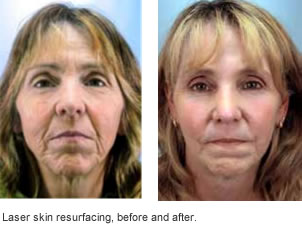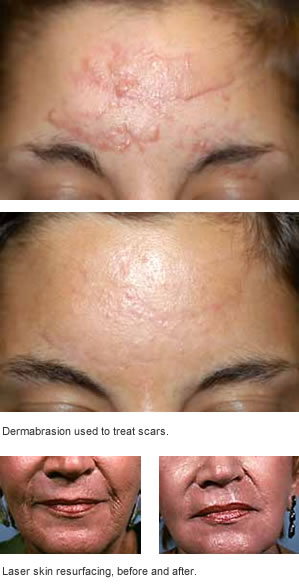Skin Resurfacing & Peels
Understanding Facial Peels and Laser Surgery
Premature wrinkling is more common now than ever before. Both men and women seek facial plastic surgery to reverse the effects of sun-damaged skin. Surgery, laser, and chemical peels may improve the pitted look of acne scars and remove pre-cancerous skin growths called keratoses.
About the time I realized that my regular workouts weren’t going to reverse these signs of aging, I became aware of laser resurfacing. Now, after full-face resurfacing, the lines are much less noticeable, and my skin looks young and fresh again. It’s just what I needed to get me over the hump of turning 40.
—tpeck, age 40

Understanding Skin Resurfacing
(Chemical Peels, Dermabrasion, Laser)
The skin is composed of the epidermis and the dermis. Within the dermis are layers constructed of collagen, long fibers that loosen and stretch with age and sun damage. Chemical peels, dermabrasion, and laser can be used to resurface the layers of the skin to reverse the changes of aging and sun damage.
In a chemical peel, the surgeon applies one of several chemicals to the skin. Glycolic acid, TCA or trichloroacetic acid, and phenol are commonly used agents in skin resurfacing. These can be applied to the skin in varying strengths to achieve superficial, medium, or deep-depth chemical peeling. Your facial plastic surgeon can help you decide which chemical peel is right for your skin. Before any peel, the face is first thoroughly cleansed with a solution to remove oil and to prepare the skin for treatment. As the chemical is applied, it penetrates into the epidermis and the upper layer of the dermis. As the treated skin heals, new collagen is formed and the skin becomes smoother. Age spots due to sun exposure can also be improved with chemical peels. Dermabrasion is a surgical technique where by some deeper scars and wrinkles can be smoothed. The surgeon uses a local anesthetic and/or a freezing agent to render the skin numb. Then, using a high-speed rotating brush, the surgeon removes the top layer of skin to the appropriate level for the best results. The size and depth of scars and the degree of wrinkling determine the length of the surgery. Common areas of treatment with dermabrasion include lip lines, acne scars, and post-traumatic scars.
Laser surgery is used to resurface facial skin with wrinkles or age spots caused by excess sun exposure or scarring caused by acne or trauma. Today, there are many types of laser options available to address the complex range of changes that occur to our skin as a result of aging, sun, and environmental exposures. For example, high-energy, amplified light waves of carbon dioxide (CO2) laser vaporize the top layer of skin instantly, with no bleeding and minimal trauma to the surrounding skin, to ultimately create a smoother surface. Your facial plastic surgeon can help you decide what type of laser treatment option is ideal for you.

A number of techniques are available today that enable facial plastic surgeons to treat a wider range of skin problems than ever before.